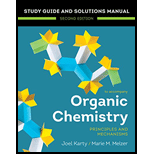
Concept explainers
Interpretation:
It is to be explained how the results of specific reactions carried out on
Concept introduction:
A chiral compound contains at least one carbon which is bonded to four different atoms or groups. D-sugar is one in which the
Want to see the full answer?
Check out a sample textbook solution
Chapter 5 Solutions
Organic Chemistry: Principles And Mechanisms: Study Guide/solutions Manual (second)
- The most stable conformation of the pyranose ring of most D-aldohexoses places the largest group, CH2OH, in the equatorial position. An exception to this is the aldohexose D-idose. Draw the two possible chair conformations of either the a or ß anomer of D-idose. Explain why the more stable conformation has the CH2OH group in the axial position.arrow_forwardDraw the isomers for each aldotetrose and ketopentose in the figure below and designate each isomer as a D or L sugar and designate also the R and S in every chiral centers. Label the enantiomers and diastereomers respectively. CH,OH C=0 Н—С—ОН Н-С—ОН Н—С—ОН H-C-OH ČH,OH ČH,OHarrow_forward1) Below you are given the structures of the disaccharides lactose and trehalose. он он но он но но OH но но OH но он но но OH Lactose Trehalose a. Identify clearly the hemiacetal and acetal groups in these disaccharides and determine for each of these identified groups if they have a- or B-configuration.arrow_forward
- Two sugars differing in configuration at a single asymmetric carbon atom are known as epimers. D-mannose is a C-2 epimer of glucose (Structure I), while D-galactose is a C-4 epimer of glucose. Structure Il and IIl are H- -OH но- -H H OH HO H но- H HO H H -OH H- -OH HO OH H -OH H- -OH H OH HO. HO, OH II II Which of the following represents an aldopentose? OH H O HO O HO H но н HO H но- HO H HO H HO- H OH H OH H OH H OH OH HO Он of но" HO O OH он III IV These are chemical messengers that are secreted by endocrine glands and carried through the bloodstream to target tissues. prostaglandin deoxysugar glycoside hormones Which of the following is NOT correctly paired? cellulose: beta-1,4-glycosidic linkage amylose: alpha-1,4-glycosidic linkage chitosan: alpha-1,4-glycosidic linkage cellubiose: beta-1,4-glycosidic linkagearrow_forwardThe disaccharide lactose is built up by one D-galacto- and one D-gluco monosaccharide unit. Draw L-galactose in the Fischer projection (open) form and in its most stable pyranose ring conformation form and determine if the latter is a 1C4 or a 4C1 conformation.arrow_forwardDraw the structures (using chair conformations of pyranoses) of the following disaccharides.(a) 4-O-(a-d-glucopyranosyl)-d-galactopyranose(arrow_forward
- OH ОН Which monosaccharide has a greater heat of combustion, B-D-glucopyranose or B-D-allopyranose? Explain. но НО Но OH OH OH OH OH B-D-Glucopyranose B-D-Allopyranosearrow_forward(h) Identify B-D-altrose and a-D-altrose from the monosaccharides shown below. VI I CH2OH O. CH2OH II H V ОН, IV H III OH OH H (i) The monosaccharide below is a(n) (d-aldopentose, R-aldopentose, S- aldopentose, L-aldopentose, D-aldopentose).arrow_forwardCellulose is not digestible by humans because it contains glucose units linked by -glycosidic bonds. O a-1,6 O a-1,4 O a-1,2 O B-1,4 O B-1,2arrow_forward
- The structure of 4 isomers of ketopentose are shown. 1) select every structure that is a diastereomer of structure D A, B, or C? 2) select every structure that is a enantiomer of structure C A, B, or D 3) select every structure that is a stereoisomer of structure C A, B, or Darrow_forward1. Which of the following is not true to the monosaccharide below? H. ОН но- -H- но ОН ĆH2OH O It is the Fischer Projection of D-glucose. It is an aldohexose having 4 chiral centers and 24 stereoisomers. It is has a D-glucose because OH- group bonded to the highest numbered chiral C is pointing to the right. It is a polyhydroxy ketone having 8 enantiomeric pair.arrow_forwardName the monosaccharide below. Make sure to denote D or L and a or B. Draw the Fischer projection of the monosaccharide. (It's an aldohexose). CH2OH OH OH ОН OHarrow_forward
 ChemistryChemistryISBN:9781305957404Author:Steven S. Zumdahl, Susan A. Zumdahl, Donald J. DeCostePublisher:Cengage Learning
ChemistryChemistryISBN:9781305957404Author:Steven S. Zumdahl, Susan A. Zumdahl, Donald J. DeCostePublisher:Cengage Learning ChemistryChemistryISBN:9781259911156Author:Raymond Chang Dr., Jason Overby ProfessorPublisher:McGraw-Hill Education
ChemistryChemistryISBN:9781259911156Author:Raymond Chang Dr., Jason Overby ProfessorPublisher:McGraw-Hill Education Principles of Instrumental AnalysisChemistryISBN:9781305577213Author:Douglas A. Skoog, F. James Holler, Stanley R. CrouchPublisher:Cengage Learning
Principles of Instrumental AnalysisChemistryISBN:9781305577213Author:Douglas A. Skoog, F. James Holler, Stanley R. CrouchPublisher:Cengage Learning Organic ChemistryChemistryISBN:9780078021558Author:Janice Gorzynski Smith Dr.Publisher:McGraw-Hill Education
Organic ChemistryChemistryISBN:9780078021558Author:Janice Gorzynski Smith Dr.Publisher:McGraw-Hill Education Chemistry: Principles and ReactionsChemistryISBN:9781305079373Author:William L. Masterton, Cecile N. HurleyPublisher:Cengage Learning
Chemistry: Principles and ReactionsChemistryISBN:9781305079373Author:William L. Masterton, Cecile N. HurleyPublisher:Cengage Learning Elementary Principles of Chemical Processes, Bind...ChemistryISBN:9781118431221Author:Richard M. Felder, Ronald W. Rousseau, Lisa G. BullardPublisher:WILEY
Elementary Principles of Chemical Processes, Bind...ChemistryISBN:9781118431221Author:Richard M. Felder, Ronald W. Rousseau, Lisa G. BullardPublisher:WILEY





